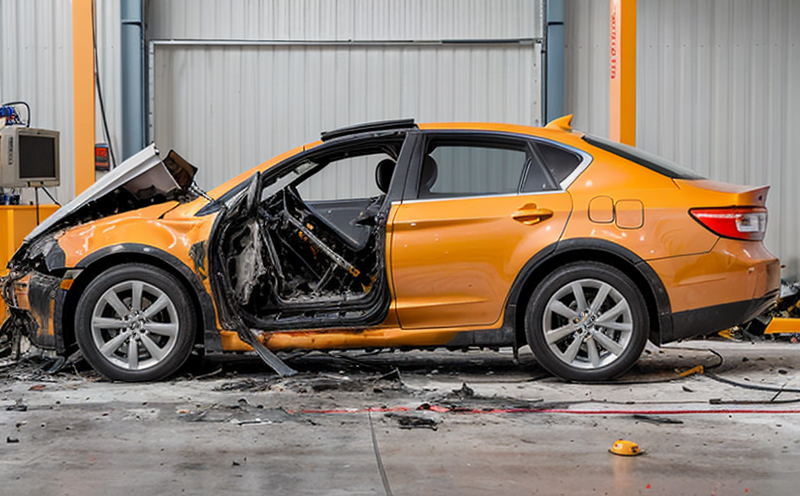IEC 62987 Mechanical Abuse Testing of Traction Batteries for Industrial Trucks
The International Electrotechnical Commission (IEC) standard IEC 62987 specifies the requirements and procedures for mechanical abuse testing of traction batteries used in industrial trucks. This service ensures that these critical components meet safety and performance standards under simulated real-world conditions, enhancing overall product reliability.
Traction batteries in industrial trucks are subjected to a variety of stresses during operation, including impacts, vibrations, and other forms of mechanical abuse. IEC 62987 aims to replicate such scenarios through standardized testing protocols that simulate these potential hazards. The purpose is not only to evaluate the structural integrity and operational performance but also to identify any vulnerabilities or weaknesses in design that could lead to failures.
The standard covers a range of tests designed to assess different aspects of battery durability, including drop tests from varying heights onto hard surfaces, compression tests at specific pressures, and more. Each test is meticulously designed to mimic the types of abuse encountered during normal use. This approach ensures that manufacturers can confidently design batteries capable of withstanding these stresses without compromising safety or functionality.
IEC 62987 emphasizes the importance of pre-test preparation. Specimens must be carefully prepared according to specified guidelines, ensuring they are representative of real-world conditions as closely as possible. Post-testing evaluation involves detailed assessments of structural damage, electrical performance metrics, and operational parameters. This comprehensive analysis provides valuable insights into how well a battery performs under stress.
By adhering to IEC 62987, organizations demonstrate their commitment to safety and quality assurance. This not only protects end-users but also enhances brand reputation by showcasing robust product development practices. Additionally, compliance with this standard helps businesses navigate regulatory requirements more effectively, fostering smoother market entry processes.
Understanding the nuances of IEC 62987 is crucial for those involved in R&D, quality assurance, and procurement within relevant industries. It ensures that all stakeholders are aligned on testing methodologies and criteria, promoting consistency across projects. For instance, during product development stages, engineers rely heavily on this standard to inform design decisions and optimize performance characteristics.
In summary, IEC 62987 mechanical abuse testing is essential for ensuring the safety and reliability of traction batteries in industrial trucks. Through rigorous simulation of real-world conditions, this service helps manufacturers create products that not only meet but exceed expectations regarding durability and performance. Compliance with these standards contributes significantly towards safeguarding end-users while fostering innovation within the industry.
Why It Matters
The significance of IEC 62987 mechanical abuse testing lies in its role as a cornerstone for ensuring safety and reliability in industrial truck batteries. By simulating various forms of mechanical stress, this standard helps identify potential weaknesses early on in the development process. This proactive approach ensures that any issues are addressed before they become critical problems during actual operations.
From an operational standpoint, reliable batteries enhance productivity by minimizing downtime caused by failures. In environments where time is money—such as warehouses or manufacturing facilities—unreliable equipment can result in significant losses. Compliance with IEC 62987 helps mitigate these risks, providing peace of mind for both operators and management.
Moreover, adherence to this standard reflects a commitment to responsible engineering practices. It demonstrates that manufacturers prioritize user safety above all else. This attitude fosters trust among customers who value high-quality products backed by robust testing protocols.
- Enhanced Safety: By replicating real-world stresses during manufacturing and usage, IEC 62987 helps prevent accidents caused by battery failures.
- Better Product Performance: Simulated abuse tests allow manufacturers to refine designs for improved reliability and longevity.
- Regulatory Compliance: Meeting this standard ensures that products meet international safety standards, facilitating easier market access.
In essence, IEC 62987 mechanical abuse testing is vital for maintaining operational efficiency while promoting a culture of continuous improvement in industrial truck battery design and manufacturing.
Industry Applications
- Warehouse Logistics: In warehouses where electric forklifts are used extensively, ensuring the safety and reliability of batteries is paramount. IEC 62987 testing plays a crucial role in safeguarding workers and equipment.
- Manufacturing Plants: For manufacturers relying on powered industrial trucks, regular mechanical abuse testing ensures that batteries perform consistently across all shifts.
- Retail Distribution Centers: Efficient operation of delivery vehicles depends heavily on reliable battery performance. Compliance with IEC 62987 supports smooth day-to-day operations.
In addition to these specific applications, the broader context involves any industry requiring powered industrial trucks for material handling or transport tasks. Across sectors like construction, agriculture, and mining, reliability of batteries is critical for maintaining productivity levels.
The benefits extend beyond individual organizations; they contribute positively towards overall safety standards within respective industries. By adhering to IEC 62987 mechanical abuse testing requirements, companies play a part in advancing the collective understanding of best practices related to industrial truck battery design and maintenance.
Competitive Advantage and Market Impact
The adoption of IEC 62987 mechanical abuse testing offers significant advantages for businesses operating within competitive markets. Firstly, it provides a clear differentiator by demonstrating a commitment to quality assurance through rigorous testing procedures. This can be particularly appealing to customers seeking reassurance about the safety and durability of purchased products.
Secondly, compliance with this standard opens up opportunities for international expansion. Many countries have adopted similar standards, making it easier for companies to sell internationally without additional certifications or modifications. This global acceptance enhances market reach and competitiveness.
- Increased Customer Trust: Demonstrating adherence to recognized international standards fosters trust among potential buyers.
- Better Risk Management: Identifying potential issues early through testing minimizes risks associated with product failures.
- Promotes Innovation: The requirement for continuous improvement encourages manufacturers to innovate continuously, leading to better products and services.
In conclusion, integrating IEC 62987 mechanical abuse testing into business practices not only strengthens current operations but also positions companies favorably in evolving markets. It enables firms to build stronger relationships with customers while staying ahead of industry trends.





